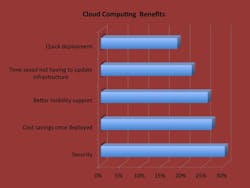With more than half of IT professionals across industries saying there are significant business benefits to the use of cloud computing, it’s now safe to say that the concept has reached an important acceptance milestone. Unless something dramatic occurs to inhibit wider implementation of the technology in manufacturing in the next few years, I predict that its implementation will follow much the same path as industrial Ethernet has over the last several years.
Ten years ago, most engineers I spoke with considered Ethernet to be a purely front-office technology unsuitable for use on the plant floor. Now, according to Automation World research, many engineers consider the incorporation of Ethernet into automation to be the most significant automation innovation of the past decade.
Research conducted by Qumu (a video platform provider) of more than 700 IT professionals, revealed that 44.4 percent of respondents plan to move applications to the cloud within the next 12 months. Thirty-three percent says this move to the cloud will comprise half of the applications they run.
Though many of these 700 respondents may not work in manufacturing industries, the trend is clear. And I would point again to the precedent set by Ethernet as a technology not endemic to manufacturing that proved its worth and moved quickly into the industrial realm.
Of particular interest in Qumu’s study is that 30 percent of respondents cited better security as a benefit to cloud computing. While this may seem counter-intuitive, the headaches of internal IT security management are growing exponentially. The ability to store information elsewhere and have it secured in a far more robust manner than is possible at many companies is certain to have its allure.
Other benefits respondents see in cloud computing include:
• Cost savings once deployed: 26.9 percent
• Better mobility support: 25.9 percent
• Time saved not having to update infrastructure: 22 percent
• Quick deployment: 18.5 percent
• Better for the environment: 12.6 percent
• Elasticity to scale up or down as needed: 11 percent
• Outsourced system support and maintenance: 10.9 percent
Nearly 45 percent of respondents are already running some applications via cloud computing. The main applications currently deployed in the cloud are:
• Email: 25.9 percent
• Storage: 24 percent
• Document management: 13.9 percent
• Employee portals: 11.3 percent
• Project management 11 percent
• Video communication: 10.3 percent
• Customer Relationship Management software: 10.3 percent
• Marketing automation: 6.8 percent


